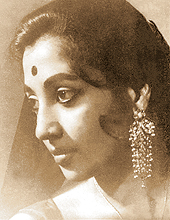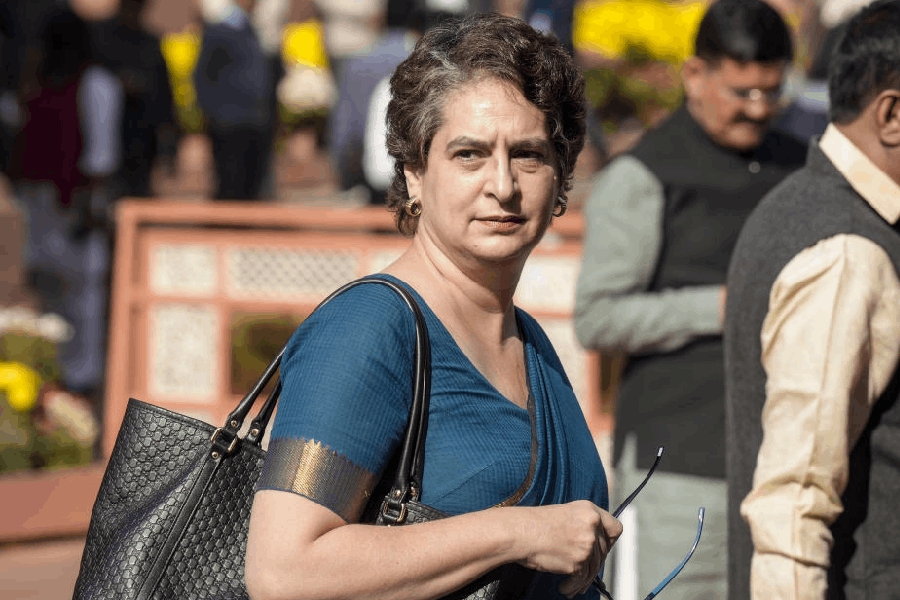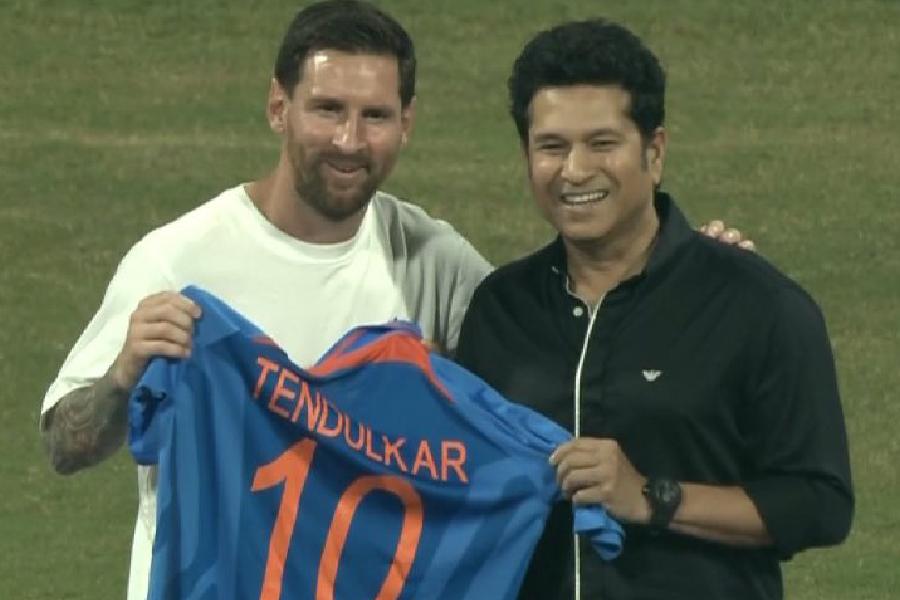 |
 |
 |
| Leading ladies then: Suchitra Sen (top), Aparna Sen and Supriya Chowdhury |
Where have all the Bengali beauties gone? Mumbai, Delhi, Bangalore and Boston have picked them all.
Oh, when will we ever learn? When will we ever learn?
We won’t. We learn only about brain drain. Know that the best and brightest have left our shores to make their lives elsewhere. But we learn not about the beauty drain — and are probably not even aware.
Well, except for the sworn birdwatcher. Heterosexual, urban, educated, bourgeois, male. Or, the species that, too, like the bird is a threatened category. Why? Because he’s also the guy who’s left.
One such has just hit town. Sambaran Mitra, a mariner in his early thirties, considers himself a veteran birdwatcher.
On a night out in Park Street, he exclaims: “Where are the babes gone?” If you can’t find them in Park Street, you can’t find them anywhere.
So Sambaran returns home. Mind phres nehi hua.
That needs some explaining. He recalls his early birdwatching days.
“If you had a long day and were burdened with the weight of the world on your shoulders, all you needed to do was walk to the balcony and look down on the streets. And invariably, there she would be, your knight in a shiny dress shimmying round the corner to rescue your soul.”
The sunshine girl.
“And as my janitor friend would say standing next to me taking a drag on his bidi, ‘Mind phres ho gaya’.”
Now even rock shows, he complains, don’t throw up hot babes!
Where are they? A simple answer to that would be: “In Delhi, in Mumbai, in Bangalore, in London, in Los Angeles,” where the money is, for economics has a deep relationship with aesthetics, and we are talking not only about the Presidency girl.
Ahh, the Presi girl.
That was the Eighties and she looked like Suchitra Sen and read Schumpeter, which means she studied economics. And it’s not that she didn’t have competition.
So the birdwatcher of yore had a lot to do, assuming watching is a male prerogative. For women, assuming they are interested in the men, wouldn’t have much watching to do. Bengali men didn’t ever have much to show except their potbellies and glass-bottom specs — not pecs. He doesn’t require to be photogenic, heroic, or hygienic. His CV was, and is, his sex appeal. His life is his mind. If not, look in his wallet.
 |
 |
 |
| And now: Swastika Mukherjee (top), Rituparna Sengupta and Priyanka |
“Bengali men have always had the temperament of the zamindar, but not the fine physique, smartness, charm or even a proper dress sense to draw the attention of the opposite sex,” says make-up artist and sculptor Gosto Kumar.
The burden of beauty fell on women. And they obliged. But that was then.
Real life reflects on the screen. In the beginning was Suchitra Sen. When she looked archly from the corner of her wide, black eyes and sang “tumi-i bolo” to Uttam Kumar’s “Ei path jodi na shesh hoy…” riding pillion, an entire generation wanted a bike but couldn’t because the EMI hadn’t yet been discovered.
Calcutta is still whipped into a frenzy to see blurred images of her with silver-grey hair.
Another Sen, the poet Jeebanananda’s imaginary Bonolata, belonged to the same tradition in the popular mind, only more ineffable.
Maybe it was a conspiracy of class and caste, but they embodied the “feminine mystique” for the Bengali. “Sari, big red bindi, gorgeous waist, long pallu, sleeveless blouse, hair hanging free and furious like Durga,” says Devashish Makhija, a film-maker.
“In my mind that is the Bengali woman I make love to, getting lost in the aranya (forest) of her hair.”
Jeebanananda, who compared Bonolata’s eyes to a bird’s nest, may squirm at that attempt at poetry but for yesterday’s birdwatcher the world was a chirpy forest. There was much to get lost in on a visit to the Coffee House (College Street), Presidency College, the Xavier’s Green Benches, Xavotsav, the Jadavpur lobby, the Maddox Square puja pandal, and who didn’t look forward to a wedding, well into the Nineties.
Then there was deforestation. Demolition, actually. The JU lobby and the Green Benches at Xavier’s were pulled down. And the girls left.
The young, talented, ambitious girls began to leave the city almost as much as the men did. According to the Calcutta University records and statistics section, almost the same number of male and female students go away after graduation, mostly from Presidency, St Xavier’s and other well-known colleges.
The boys had been leaving. But when the best and the brightest of the feminine gender leave, they take with them the beauty.
Calcutta’s economic decline has coincided with beauty — and brain — drain.
“You don’t know how dull the JU campus is,” says a hardened campus visitor. “The best are simply missing,” she adds.
Surveys are yet to be conducted on the number of beauties Calcutta has lost to the lures of Mumbai, for professional reasons, and Maryland (for which you can blame the dollar-jingling NRI who flies down in the winter and flies away with a beauteous bride before you can say winter).
Bipasha Basu left immediately after making it big. Some other knockout Bengalis (meaning anyone born and brought up in Bengal), like Koena Mitra, Celina Jaitley, Riya and Raima Sen, also hotfooted it to Mumbai.
Sushmita (Yes! Sen again), who is not from Calcutta but an honorary Bengali, only visits the city to see her relatives.
Then there are those who remain nameless. Like the Presi girl and the office floor scorcher, who don’t seem to be there in large numbers.
A promo of the upcoming Bengali film Trishna, showing Rituparna Sengupta emerging from the sea in a backless and midriff-baring crochet top and mini skirt, permed hair flying around her face, greets those passing through Park Street. But even she’s trying her luck in Mumbai.
Calcutta, looks like, has no perch for the pretty.
Many don’t agree. They believe that the traditional Bengali beauty is just buried beneath tonnes of bad make-up. Strange clothes, too.
| Fled the nest |
 |
 |
 |
 |
| From top: Bipasha Basu, Riya Sen, Celina Jaitley, Raima Sen |
“The kind of clothes Bengali women wear on the upper regions of their body is discrepant with their look. Bengali women wear tops that are designed to imitate the tops that European women wear. This is disgusting. The other day I saw a Bengali newscaster wearing such a top and she looked very ugly as she had a very Bengali face that did not go with her look,” says Ganesh Pyne, the artist.
The Bengali woman has traditionally been proud of her curves. But jeans are not flattering to a curvaceous body and those who know it hit the gym to iron themselves out.
“It’s the time for the unisex look and girls are also wearing jeans. But I don’t mind,” says writer Sunil Gangopadhyay, the creator of another Bengali feminine ideal, Neera, presumably made of poetry. “But at weddings, when they go back to the sari, it feels good.”
So is it the missing sari that has robbed the Bengali beauty of her beauty? There may be something in that. “The mystery of the Bengali woman is missing. There is nothing left to discover,” laughs Aniruddha Chakladar, a make-up artist.
“Everyone has the same hair, wears similar clothes and make-up and uses the same language. It’s a very clonish generation,” he adds.
Who has the time to drape a sari and brush long, lustrous hair when she has to drop the kid to school at eight, reach a meeting at 10, finish the project report by six, cook dinner, help the kid with homework… phew!!! Do you know what it is like to be an urban, educated woman these days?
Decades have passed since Suchitra Sen and the sari. “I wear pants!” this lady says. “In the house too!” she says.
Clothes, sadly, can only enhance beauty, can’t hide it. So the theory that the secret behind the missing Bengali beauties is the absent sari doesn’t cut much ice, or cloth.
There are young men who support the modern woman dressing in modern clothes. They don’t feel the beauty is missing, either.
“I wouldn’t say that the beautiful Bengali faces are missing. I would say their look has changed,” says Parambrata Chatterjee, an actor.
“Modern High, La Martiniere for Girls, JU and Presidency used to be places for the boys to look for pretty faces. A fortnight back, I was again at both JU and Presidency to promote my film Kalbela, and it did not seem that the beautiful faces had left campus,” he adds.
Beauty is in the eyes of the beholder, the cliché goes. But birdwatcher Sambaran still feels something is amiss. “A heterosexual man has a kind of sensor, a third eye whereby he can feel the presence of sunshine in his proximity. The range and accuracy of the radar can differ from man to man. Once a target is sensed, some stare, some glance, some smile, some sneak a peek.”
That sensor, he says, is not going beep beep.
Forget about the Nano leaving Bengal. It’s only a car. Sunshine may have gone from our midst.
The new hot spots
NUJS: This might be the new JU or Presidency campus. With a melting pot of students from across India and even some NRIs, this is the new hot spot for birdwatchers.
 |
NIFT: The youngsters aiming to dress others prettily do some innovative dressing themselves. The result is often quirky, but beautiful.
Malls: “In typical guyspeak, you get bhalo family-r meye here,” says Mir, a t2 columnist. South City is the top draw, but the Kund area in City Centre is popular, too.
Multiplex: When the light comes on during the interval, if you are lucky, you might find yourself sitting beside a beautiful babe.
Libraries at British Council and American Center: Books may not be your thing, but trust us, a pair of specs on a pretty face can add to the charm.
Unisex salon: Not only the chic salon attendant, but the pretty customer getting a pedicure can be worth your visit.
Salt Lake markets: For the girls from the Northeast.











